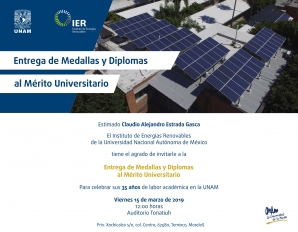Abstract
Due to water pollution at urban as well as industrial and rural level, there exists the need to introduce and improve new alternative technologies to traditional methods for waste water treatment. It is important that new technologies must be economic, effective and environment friendly. The above mentioned alternative technologies are in this case the heterogeneous photocatalysis with TiO2 and photo-Fenton processes which use the solar radiation as exciting source to produce species highly oxidative that can degrade the organic matter present in polluted water. This paper describes the construction of a Photocatalytic Solar Plant located at the installations of the Energy Research Center of the National University of Mexico (CIE-UNAM), which is composed by different photocatalytic reactor integrated with CPC solar concentrators whose concentration varies between 1 and 2 suns. The photoreactors and equipped with temperature, pH, COD and DO online sensors. Moreover, the plant counts with an analytical laboratory equipped with a Total Organic Carbon(TOC) analyzer and a UV-VIS spectrophotometer. In addition, immobilized TiO2 photocatalysts on glass pipes Pyrex® were prepared, which lately were introduced into the photocatalytic reactor. The catalyst immobilization on glass pipes eliminates in an effective way the recovery process of powder photocatalysts, and also saves time and work costs. The technical feasibility and performance of the photocatalytic degradation of the plaguicide carbaryl at pilot level have been here studied.
Ivan SalgadoTránsito, Antonio E. Jiménez González, Claudio A. Estrada Gasca, Camilo Arancibia Bulnes, Rogelio Morán Elvira, Carlos Antonio Pineda Arellano, Eduardo Iragorri, Cesar Pérez Franco and Emmanuel Hernández Martínez


